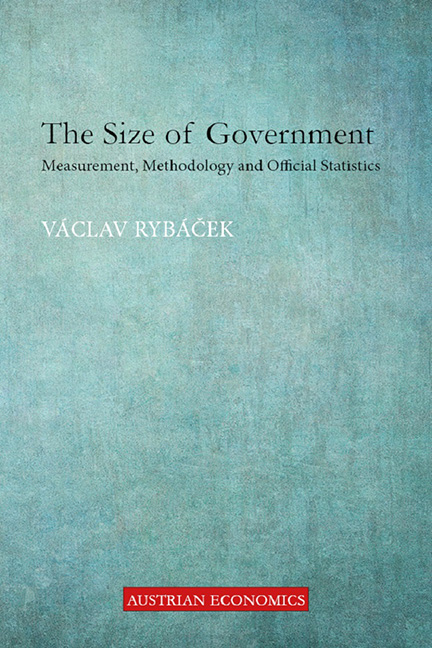Book contents
- Frontmatter
- Contents
- Introduction
- Chapter 1 The Size of Government in Economics
- Chapter 2 The Role of Measuring Government in Economic Policy
- Chapter 3 A Short Trip to the Past
- Chapter 4 The Current Approach
- Chapter 5 What’s Wrong with the Current Approach?
- Chapter 6 The Size of Government and GDP
- Chapter 7 Is the Size of Government Underestimated?
- Chapter 8 Recalculation of the Size of Government
- Conclusion
- Notes
- Bibliography
- Index
Chapter 6 - The Size of Government and GDP
Published online by Cambridge University Press: 09 August 2023
- Frontmatter
- Contents
- Introduction
- Chapter 1 The Size of Government in Economics
- Chapter 2 The Role of Measuring Government in Economic Policy
- Chapter 3 A Short Trip to the Past
- Chapter 4 The Current Approach
- Chapter 5 What’s Wrong with the Current Approach?
- Chapter 6 The Size of Government and GDP
- Chapter 7 Is the Size of Government Underestimated?
- Chapter 8 Recalculation of the Size of Government
- Conclusion
- Notes
- Bibliography
- Index
Summary
High-profile fiscal indicators are presented in relative terms, as a percentage of GDP. Although the general public is accustomed to this way of presentation, it is a mere convention. The truth is that GDP was not designed to serve this purpose. Rather it was meant to be an indicator of cyclical fluctuations and the statistical quantification of the taxable capacity of the economy for the purposes of public finance management during wartime. Since then the utilization of GDP has further expanded to such areas as well-being comparison, living standards measurement, etc. Along with these, the methodology has been developed into greater detail and it may have gone too far in its measurement of productive capacity of economies.
There is no denying that the relative size of government and government debt is a very comprehensible way to compare figures internationally and to show to voters the success or failure of economic policy. Nevertheless, from the methodological perspective, this approach does not make much sense. Even statisticians themselves admit that expressing the size of government in this way is not ideal and remains open to criticism (Lequiller & Blades 2014). One of the key points is what kind of information do we actually expect these figures to tell us? Is it the share of taxable income government drains from society? And does the relative size of government debt indicate whether government is capable of paying off its debt? Before answering these questions, we have to first discuss some details of the way GDP is calculated.
When showing the volatility in the statistical indicators and their methodology, we will seek to recalculate both the numerator and denominator of fiscal ratios. In doing so, we will exclude that part of the economy which does not, or cannot, serve as a source of government financing. It should be noted that GDP does not include, by definition, certain incomes which are commonly taxed, such as revenues from interest, rents on land and other natural resources and, not least, dividends. Of course, all calculations that follow are rough estimations based on simplistic assumptions, however, so are the official figures.
- Type
- Chapter
- Information
- The Size of GovernmentMeasurement, Methodology and Official Statistics, pp. 111 - 128Publisher: Agenda PublishingPrint publication year: 2019



